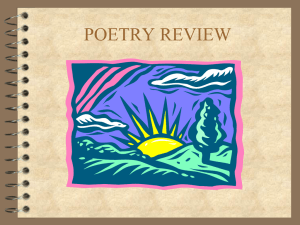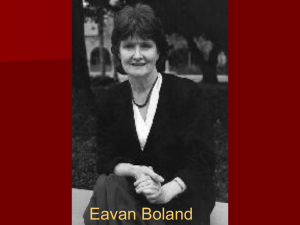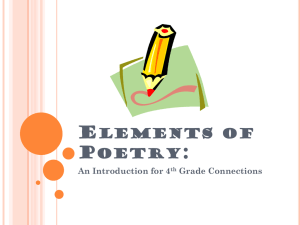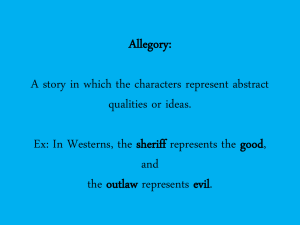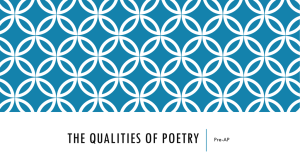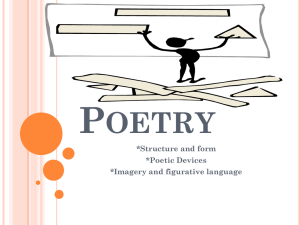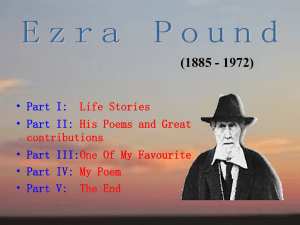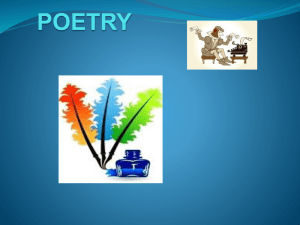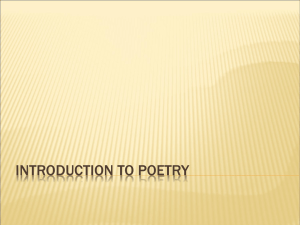An Introduction to Poetry: Elements & Techniques
advertisement
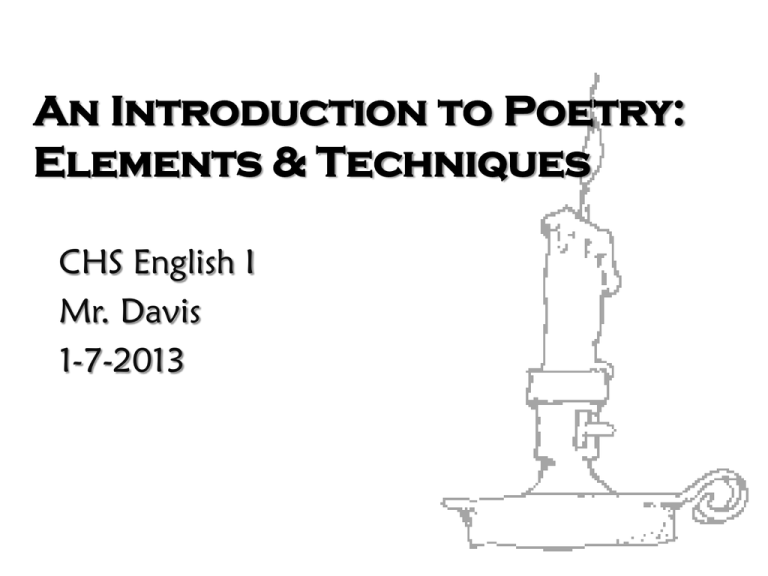
An Introduction to Poetry: Elements & Techniques CHS English I Mr. Davis 1-7-2013 SOUNDS OF POETRY • Alliteration: Using the same consonant to start two or more stressed words or syllables in a phrase or verse line, or using a series of vowels to begin such words or syllables in sequence. Alliteration need not re-use all initial consonants: words like “train” and “terrific” are alliterate. • Assonance: The rhyming of a word with another in one or more of their accented vowels, but not in their consonants; sometimes called vowel rhyme. • Consonance: Sometimes just a resemblance in sound between two words, or an initial or head rhyme like alliteration, but also refined to mean shared consonants, whether in sequence (“bud” and “bad”) or reversed (“bud” and “dab”). • Onomatopoeia: A word that imitates a noise or action. Example: “buzz” FIGURES OF SPEECH • Simile: A comparison made with “as,” “like,” or “than.” • Metaphor: Compares two different things without using a word of comparison, such as “like” or “as.” • Hyperbole: Exaggeration beyond reason – sometimes meant to be funny. • Personification: A figure of speech where the poet describes an abstraction, thing, or a non-human form as if it were a person. TECHNIQUES • Imagery: A set of mental pictures or images; the use of vivid or figurative language to represent objects, actions, or ideas; the use of expressive or evocative images in art, literature, or music; a group or body of related images, as in a painting or poem. • Strong Verbs: Using powerful verbs to portray vividly an event in a story or poem. • Symbol: A word or object that has its own meaning and represents another word, object or idea. • Mood: The feeling a poem creates for its reader. • Tone: the attitude a poet takes towards his/her subject. • Style: the way a poet uses words, forms, or imagery to create an effect on the reader. STRUCTURE • Stanza- A unit of lines grouped together. Similar to a paragraph in prose. • Couplet- A stanza consisting of TWO lines that rhyme. • Quatrain- A stanza consisting of four lines. • Refrain- The repetition of one or more phrases or lines at certain intervals, usually at the end of each stanza. Similar to the “chorus” in a song. • Repetition- A word or phrase repeated within a line or stanza. – Example: “gazed and gazed” • Rhythm: the pattern created by the stressed and unstressed syllables of words in a sequence. A controlled pattern of rhythm is called “meter.” • Rhyme: the repetition of identical or similar sounds in stressed syllables. • Rhyme Scheme: The pattern in which “end rhyme” occurs. T YPES OF POETRY • Narrative: the poet tells a story in verse form. Narrative poems include “epics” and “ballads.” Epic poems are long poems about gods and heroes (The Odyssey). Ballads are songlike poems about adventure and romance. • Dramatic: the poet tells a story using a characters own thoughts or statements. • Lyric: a brief poem in which the poet expresses the feelings of a single speaker, creating a single effect on the reader. These poems are known for their musical qualities, achieved through the use of rhyme and rhythm. FORMS OF POETRY: • Sonnet: a fourteen-line lyric poem with formal patterns of rhyme, rhythm, and line structure (Shakespearean and Italian). • Free verse: no specific patterns of rhyme, rhythm, or structure. • Haiku: a poem containing three unrhymed lines of five, seven, and five syllables. A Japanese form that uses imagery to convey a single emotion. POETRY PACKET This marks the first entry in your “Poetry Packet.” Just like with TKAM, you will take notes, answer questions, complete writing assignments, etc., and it is YOUR responsibility to keep up with your work. When we complete enough assignments, I will give you a “checklist” and you will submit your work. Your “Introduction to Poetry” worksheet is included in this packet. VOCAB: POETRY COLLECTION #1 Copy down the following vocabulary terms. Use EACH one in a sentence (correctly). 1. Defer (v): put off until a future time. 2. Pensive (adj): deeply or seriously thoughtful 3. Discerning (adj): having good judgment or understanding 4. Preliminaries (n): steps or events before a main event POETRY COLLECTION #1: 1-9-2013 1. Langston Hughes: “Dream Deferred” & “Dreams” 2. William Wordsworth: “I Wandered Lonely as a Cloud” 3. Gabriela Mistral: “Meciendo/Rocking” 4. Jean de Sponde: “Sonnets on Love XIII” RESPOND: POETRY SELECTION #1 Answer each of the following questions regarding the first selection of poems. Be sure to answer in COMPLETE sentences (restate the question in your answer!). 1. 2. 3. 4. 5. Which of these poems affected you the most, and WHY? Answer in 2-3 COMPLETE sentences. In Hughes’s “Dream Deferred,” and/or “Dreams” identify one SIMILE and one METAPHOR. To what is the poet comparing these things? (3 sentences). What are the “natural sights” (or things you would see in nature) that are described in Wordsworth’s “I Wandered Lonely as a Cloud” and Mistral’s “Meciendo/Rocking”? Answer in 2 sentences. In de Sponde’s “Sonnets on Love XIII,” to what does the speaker compare his love? What do you think this says about the speaker’s feelings? Answer in 2-3 sentences. Provide AT LEAST three examples of PERSONIFICATION from the selection of poems. Answer in 3 complete sentences. POETRY COLLECTION #2: 1-22-2013 Read Poetry Collection 2 (pages 577-581): 1. Richard Brautigan: “All watched Over by Machines of Loving Grace” 2. Emily Dickinson: “Hope is a thing with feathers” & “Much Madness is divinist Sense” 3. Stanley Kunitz: “The War Against the Trees” Answer questions 1-7 (all parts) on p. 582. Complete the “Writing” activity on p. 583. You may write a POEM or a PROSE response. Be sure to include ALL 5 SENSES in your response. POETRY COLLECTION #3: 1-23-2013 Copy the “Vocabulary Builder” terms on p. 590. Read Poetry Collection 3 (pages 592-595): 1. Walter Dean Myers: “Summer” 2. Alfred, Lord Tennyson: “The Eagle” 3. May Swenson: “Analysis of Baseball” Answer questions 1-7 (all parts) on p. 596. POETRY COLLECTION #4: 1-24-2013 Read Poetry Collection 4 (pages 599-607): 1. Edgar Allan Poe: “The Bells” 2. Yusef Komunyakaa: “Slam, Dunk, & Hook” 3. Lewis Carroll: “Jabberwocky” Answer questions 1-7 (all parts) on p. 608. Complete the “Writing” activity on p. 609. Respond in AT LEAST one 5-sentence paragraph (Intro, 3 supporting facts, conclusion) GROUP LEADER: INSTRUCTIONS 1/22-25 • You are in charge of your group in my absence. Please make sure that your members remain on task and aware of their expectations. • I have assigned a collection of poems to be read and analyzed in class each day. Please lead the group reading and discussion. How you choose to read the poems is up to your group, but ALL members must submit their own responses to the poems. • On Wednesday, January 23, you will receive a CHECKLIST for your Poetry Journal. Please make sure each member receives a copy and is aware that these are due on FRIDAY, JANUARY 25. • FRIDAY will be dedicated to READING WORKSHOP. Please make sure your group is aware of their expectations. Thanks much, Mr. Davis
